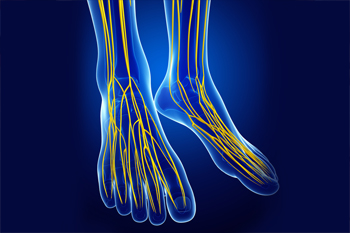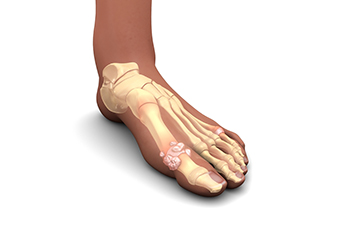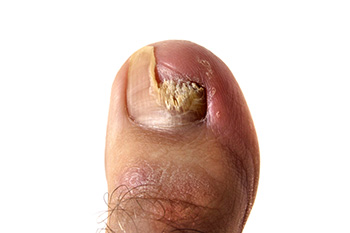Connect With Us
Blog
Items filtered by date: May 2025
What Is That Bump on the Bottom of Your Foot?

A bump on the bottom of the foot can be caused by several common conditions, including plantar warts, calluses, or a plantar fibroma. Each has distinct causes and symptoms. Plantar warts are caused by the human papillomavirus or HPV, and often appear as rough, grainy growths with tiny black dots. They may be painful when walking. Plantar calluses are thickened areas of skin that develop from repeated pressure or friction, and are typically painless unless they become very thick. A plantar fibroma is a firm, fibrous lump in the arch of the foot caused by a benign tissue growth in the plantar fascia, which may cause discomfort when walking or standing. A podiatrist can examine the bump and determine the exact cause. Treatments vary and may include cryotherapy, trimming thickened skin, orthotics, targeted exercises, or minor surgery, for fibromas. If you have a painful bump on the bottom of your foot, it is suggested that you schedule an appointment with a podiatrist for appropriate treatment.
Foot Pain
Foot pain can be extremely painful and debilitating. If you have a foot pain, consult with Patricia Mcilrath, DPM from Health One Podiatry. Our doctor will assess your condition and provide you with quality foot and ankle treatment.
Causes
Foot pain is a very broad condition that could be caused by one or more ailments. The most common include:
- Bunions
- Hammertoes
- Plantar Fasciitis
- Bone Spurs
- Corns
- Tarsal Tunnel Syndrome
- Ingrown Toenails
- Arthritis (such as Gout, Rheumatoid, and Osteoarthritis)
- Flat Feet
- Injury (from stress fractures, broken toe, foot, ankle, Achilles tendon ruptures, and sprains)
- And more
Diagnosis
To figure out the cause of foot pain, podiatrists utilize several different methods. This can range from simple visual inspections and sensation tests to X-rays and MRI scans. Prior medical history, family medical history, and any recent physical traumatic events will all be taken into consideration for a proper diagnosis.
Treatment
Treatment depends upon the cause of the foot pain. Whether it is resting, staying off the foot, or having surgery; podiatrists have a number of treatment options available for foot pain.
If you have any questions, please feel free to contact our offices located in Reading and Rittenhouse Square, PA . We offer the newest diagnostic and treatment technologies for all your foot care needs.
What Is Charcot-Marie-Tooth Disease?

Charcot-Marie-Tooth disease is a rare inherited disorder that affects the peripheral nerves, which are responsible for controlling muscles and relaying sensory information. This condition gradually damages the nerves, often leading to muscle weakness and decreased sensation in the feet and lower legs. People with Charcot-Marie-Tooth may develop high arches, curled toes, and an abnormal gait due to the weakening of foot and leg muscles. Over time, the condition can result in balance issues, foot deformities, and difficulty walking. Symptoms often begin in childhood or early adulthood and typically progress slowly. While there is no cure, treatment options like custom orthotics and supportive footwear can help manage discomfort and improve mobility for those living with this lifelong condition. If you have this condition, it is suggested that you are under the care of a podiatrist who can help you to manage Charcot-Marie-Tooth disease.
Some foot conditions may require additional professional care. If you have any concerns, contact Patricia Mcilrath, DPM of Health One Podiatry. Our doctor can provide the care you need to keep you pain-free and on your feet.
Rare Foot Conditions
The majority of foot conditions are common and can be treated by a podiatrist. Standard diagnostic procedures are generally used to identify specific conditions and treatment can be rendered. A podiatrist also treats rare foot conditions which can be difficult to diagnose and may need extra attention and care.
There are many rare foot conditions that can affect children. Some of these can include:
- Freiberg’s disease
- Kohler’s disease
- Maffucci syndrome
Freiberg’s disease - This can be seen as a deterioration and flattening of a metatarsal bone that exists in the ball of the foot. It typically affects pre-teen and teenage girls, but can affect anyone at any age. Symptoms that can accompany this can be swelling, stiffness, and the patient may limp.
Kohler’s disease - This often targets the bone in the arch of the foot and affects younger boys. It can lead to an interruption of the blood supply which ultimately can lead to bone deterioration. The patient may limp or experience tenderness, swelling, and redness.
Maffucci syndrome - This affects the long bones in a child’s foot leading to the development of abnormal bone lesions. They are benign growths and typically develop in early childhood and the bones may be susceptible to breaking.
A podiatrist can properly diagnose and treat all types of rare foot conditions. If your child is affected by any of these symptoms or conditions, please don’t hesitate to call our office so the correct treatment method can begin.
If you have any questions, please feel free to contact our offices located in Reading and Rittenhouse Square, PA . We offer the newest diagnostic and treatment technologies for all your foot care needs.
Can Gout Affect Children and Teenagers?

Although gout is more common in adults, children and teenagers can develop it, especially if they have certain medical conditions or a family history. Gout is a form of arthritis caused by high levels of uric acid in the blood, which can form painful crystals in the joints. It often affects the big toe, and can produce excruciating pain. In younger individuals, it may be linked to kidney problems, obesity, or inherited disorders. Symptoms include joint pain, redness, and swelling, often in the big toe. Avoiding gout in children and teens involves maintaining a healthy weight, staying hydrated, and eating a balanced diet that limits high-purine foods such as red meat and sugary drinks. If your child has pain in the big toe, it is suggested that you promptly contact a podiatrist who can accurately diagnose gout, and offer relief and treatment solutions for this painful condition.
Gout is a painful condition that can be treated. If you are seeking treatment, contact Patricia Mcilrath, DPM from Health One Podiatry. Our doctor will treat your foot and ankle needs.
What Is Gout?
Gout is a form of arthritis that is characterized by sudden, severe attacks of pain, redness, and tenderness in the joints. The condition usually affects the joint at the base of the big toe. A gout attack can occur at any random time, such as the middle of the night while you are asleep.
Symptoms
- Intense Joint Pain - Usually around the large joint of your big toe, and it most severe within the first four to twelve hours
- Lingering Discomfort - Joint discomfort may last from a few days to a few weeks
- Inflammation and Redness -Affected joints may become swollen, tender, warm and red
- Limited Range of Motion - May experience a decrease in joint mobility
Risk Factors
- Genetics - If family members have gout, you’re more likely to have it
- Medications - Diuretic medications can raise uric acid levels
- Gender/Age - Gout is more common in men until the age of 60. It is believed that estrogen protects women until that point
- Diet - Eating red meat and shellfish increases your risk
- Alcohol - Having more than two alcoholic drinks per day increases your risk
- Obesity - Obese people are at a higher risk for gout
Prior to visiting your podiatrist to receive treatment for gout, there are a few things you should do beforehand. If you have gout you should write down your symptoms--including when they started and how often you experience them, important medical information you may have, and any questions you may have. Writing down these three things will help your podiatrist in assessing your specific situation so that he or she may provide the best route of treatment for you.
If you have any questions, please feel free to contact our offices located in Reading and Rittenhouse Square, PA . We offer the newest diagnostic and treatment technologies for all your foot care needs.
Heel Pain in the Morning?
Treating Toenail Fungus With Creams and Devices

Fungal infections of the toenails can cause thickening, discoloration, and crumbling of the nail. While oral medications are sometimes used, many cases can be managed with topical or device-based treatments. Antifungal creams, gels, or medicated nail lacquers are applied directly to the nail and surrounding skin. These treatments work best when used consistently and in the early stages of infection. In addition to topical solutions, device-based options like laser therapy are becoming more common. Lasers target the fungus beneath the nail without damaging surrounding tissue, and are typically done in a podiatrist’s office. Another approach involves mechanical thinning or filing of the nail to help treatments penetrate deeper. Results can take several months, as toenails grow slowly. If you have a stubborn or worsening toenail infection, it is suggested that you see a podiatrist for a diagnosis and treatment that is right for you.
For more information about treatment, contact Patricia Mcilrath, DPM of Health One Podiatry. Our doctor can provide the care you need to keep you pain-free and on your feet.
Toenail Fungus Treatment
Toenail fungus is a condition that affects many people and can be especially hard to get rid of. Fortunately, there are several methods to go about treating and avoiding it.
Antifungals & Deterrence
Oral antifungal medicine has been shown to be effective in many cases. It is important to consult with a podiatrist to determine the proper regiment for you, or potentially explore other options.
Applying foot powder on the feet and shoes helps keep the feet free of moisture and sweat.
Sandals or open toed shoes – Wearing these will allow air movement and help keep feet dry. They also expose your feet to light, which fungus cannot tolerate. Socks with moisture wicking material also help as well.
If you have any questions please contact our offices located in Reading and Rittenhouse Square, PA . We offer the newest diagnostic and treatment technologies for all your foot and ankle needs.

